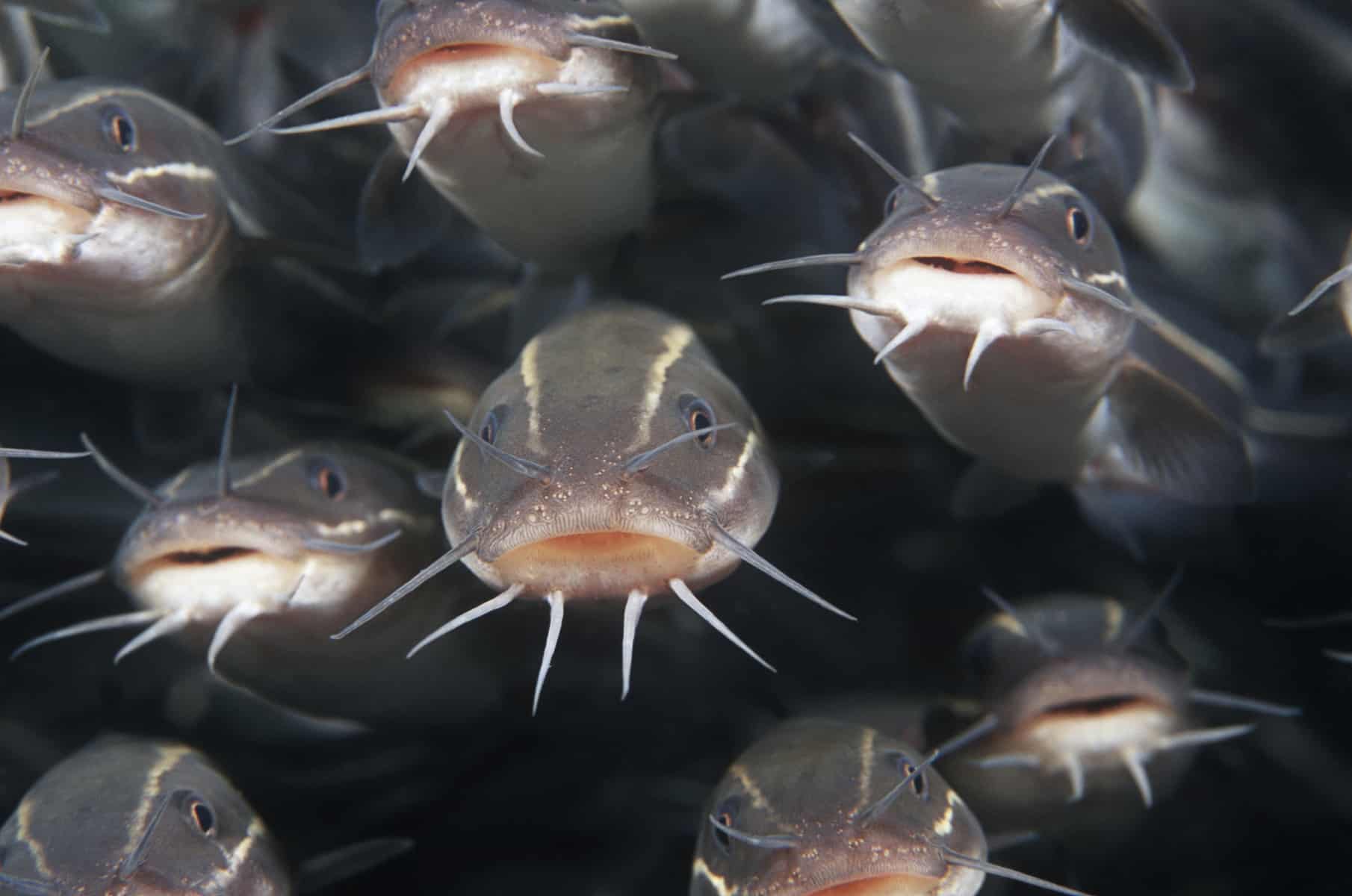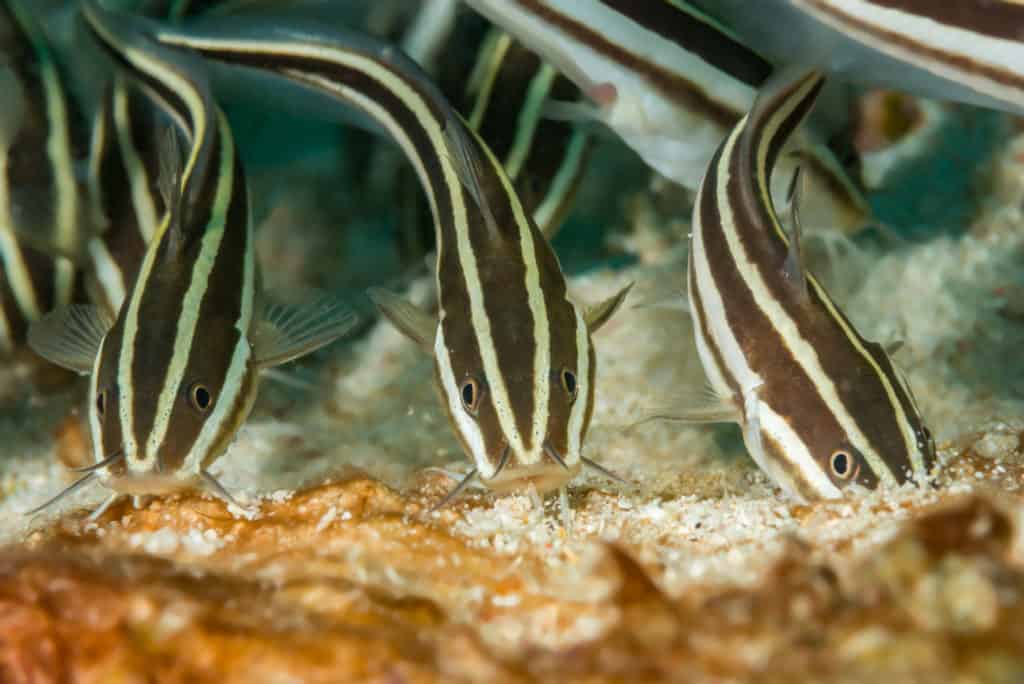The Raphael catfish is a characterful, appealing freshwater fish that makes an interesting addition to any community freshwater tank. These fish are hardy and very easy to care for, making them a good choice for novice aquarists, provided that you give your Raphael the correct diet and tank conditions.
In this guide, we explain how to care for the enigmatic Raphael catfish, including tips on how to handle these spiky customers!

Raphael catfish – overview
Raphael catfish are also known as:
- Talking catfish
- Southern striped catfish
- Chocolate doradid
- Chocolate catfish
- Humbug catfish
- Thorny catfish
- Striped Raphael catfish
The Raphael’s scientific name is Platydoras armatulus, and it belongs to the Doradidae family.
Although members of the same family, the Spotted catfish is a different species with the scientific name Agamyxis Pectinifrons, and the two should not be confused.
Thorny catfish are one of the larger species of catfish that come from South America and have plenty of desirable features that make them popular as aquarium specimens.
Raphael catfish Platydoras armatulus is naturally curious and active, making these fish great fun to observe. Like most catfish species, Raphaels are easy to look after and extremely hardy, having an average lifespan of up to 15 years.
Appearance
The fish has a long body that’s shaped like a tadpole, and the bold black and white stripes combine to make the Striped Raphael catfish a real stunner. These catfish should not be confused with Platydoras Costatus that is native to French Guiana and Suriname, where the species has a pale stripe that doesn’t extend onto the head.
Both sexes of the Striped Raphael catfish look pretty much identical, although the males can be darker in color, and the females tend to be more of a cream color between the stripes, whereas the males are yellowish tan.
Platydoras armatulus is an armored catfish that has a set of spines running along the length of its lateral line. The fish also has dagger-like, very pronounced pectoral and dorsal fins, forming a highly effective defensive barrier against predators. For that reason, extreme care should be taken when handling or netting the Striped Raphael catfish to prevent injury to yourself and to the fish.
These large catfish generally grow to measure between seven and nine inches in length. They are very slow-growing, especially once they’ve reached the six-inch mark. After that stage in their development, the fish grow just one inch every year or two.
So, why is the Raphael catfish also known as the Talking catfish?
Well, like other members of the Doradid catfish family, the Raphael catfish makes a peculiar, guttural croaking sound or emits a series of squeaks when alarmed or threatened.

Origins
The Talking catfish comes from Paraguay, lower Orinoco, and Paraná basins in South America.
In the wild, the fish burrow into the soft, sandy bottom of their river home, feeding on crustaceans, mollusks, and organic debris.
Like many catfish species, Raphael catfish are nocturnal, coming out at night to feed and explore their habitat. During the daytime, the fish shelter in hiding places on the river bottom.
Care of the Raphael catfish
The Striped Raphael catfish is very easy to care for. Here’s a guide on how to provide your fish with what it needs to thrive.
Tank size
Raphael catfish can grow to be nine inches in length, so the recommended minimum tank volume for these fish is 30 gallons. The best tank shape is long rather than tall, as these are bottom-dwelling fish.
The minimum tank size should be 48″ x 12″ x 12″.
Water parameters
Striped Raphael catfish are incredibly hardy and will tolerate a wide pH range of between 5.5 and 7.5. However, it’s important that the pH remains stable. Water hardness should be between 0 and 20 dH.
The species lives in tropical freshwater, so the temperature in the tank should be between 730 and 860 Fahrenheit.
Although the species can survive in water that has a high nitrate level, that’s not desirable, as longterm exposure to dirty water will harm the fish. These are quite messy fish, so you will need to have an efficient filtration system in your tank with a medium flowrate. Remember to carry out partial water changes of up to 30% every week.
Tank decoration
Striped Raphael catfish are nocturnal, so you should provide plenty of hiding places where the fish can rest during the daytime.
Include plenty of live plants, rocks, caves, overhangs, and driftwood to create the perfect aquascape for your catfish. Striped Raphael catfish especially enjoy having tunnels to hide inside, so be sure to add at least one piece of terracotta pipe partly buried in the substrate to fulfill that need. These fish also tend to cram themselves inside crevices in pieces of driftwood.
When choosing plants for the aquarium, make sure that you select robust, tough species, as Striped Raphael catfish are bulky creatures that may damage delicate planting by uprooting it as they forage through the substrate.
Ideally, the substrate should be sandy and soft. Catfish platydoras have sensitive barbels that they use when foraging through the substrate for morsels of food, and gravel can inflict injury on the fish. Also, these fish feed by sucking up the substrate and filtering it through their gills, eating scraps of food, and organic matter as they do so. A gravel substrate would prevent this natural behavior and could lead to stress and even starvation.
Talking catfish like to create their own hiding places. So, if you leave a piece of slate on top of the substrate, you’ll see the fish burrowing beneath it to create a DIY cave. That’s a natural behavior that cannot be replicated with a gravel substrate.
Diet and nutrition
Talking catfish are easily pleased when it comes to food. Offer your fish a diet of sinking pellets, together with frozen and freeze-dried foods, such as brine shrimp and bloodworms. Ideally, the fish’s diet should include:
- Mysis shrimp
- Snails
- Brine shrimp with spirulina
- Pacific shrimp (not tiger shrimp)
- Krill
- Pollock or Tilapia
Always feed your catfish more invertebrates than fish.
That will provide your Striped Raphael with a diverse diet that covers the animal’s complete nutritional requirements. If you keep the snails in a separate tank, you can feed them lots of vegetables if you want to build up their nutritional value for your fish, although the algae and microfauna that the snails eat within their tank will be passed onto your Talking catfish.
Don’t deshell the snails or the shrimp. The shells are a great source of additional nutrients, as well as providing roughage that is beneficial for the catfish’s digestion.
It’s recommended that you feed mature fish a large meal every couple of days. Keep a close eye on the fish’s body shape. If the abdomen becomes very swollen, do not feed the fish, as that could lead to health problems. Juveniles should be fed small amounts on a daily basis.
Note that Platydoras armatulus do not stop eating when they’re full! These are greedy fish, and overeating can lead to obesity and even death. So, be sure not to overfeed your fish. That said, don’t be concerned if your catfish is eating a lot of snails that it finds when filter-feeding in the substrate; snails will not bloat your fish.
Tankmates
Platydoras armatulus are a peaceful species that makes a great addition to a community tank. They are not known to be especially territorial, so you can keep a small group of Raphaels without fear of aggression. It’s believed that wild Raphael catfish live in social groups, so a small school of these fish would be a great addition to a very large aquarium.
That said, care should be taken when introducing smaller fish to the setup if a Raphael catfish is already in residence, as they can be predatory and may eat fish fry and very small juvenile fish that come within range.
Most Corydoras catfish species, barbs, and other community fish larger than 2.5 inches make suitable tankmates for the Platydoras armatulus.
It’s not a good idea to keep species of very small ornamental snails or invertebrates in a community that contains these fish, as they will most likely become lunch for the catfish unless, of course, that’s your intention.
Do not keep fish species that are known to be aggressive in the same tank as your Platydoras Armatulas. When threatened, the catfish will wrap itself around the aggressor, using its rows of spines to inflict injuries that are often fatal.
That’s also why you should never attempt to handle your Striped Raphael catfish directly, as it will treat your hand in the same way as it does an aggressor. If you do need to remove the catfish from the tank, use a pitcher or cup to scoop it up. Netting this fish species is also not the best idea, as their spines and barbels can become entangled in the net, leaving you with a trapped fish and a thorny problem to disentangle!
Breeding
Raphael catfish are spawning fish, but no reports of breeding them successfully in captivity have been found. For that reason, the specimens that you will find for sale in fish stores or online are most likely wild-caught.

Availability
Although these novel freshwater fish are not seen in every local fish store, they are quite readily available if you search online around some of the better specialist aquarium supply sites.
You can generally obtain one of these Talking catfish for under $10, but do bear in mind that you will need to pay extra for shipping if you can’t find a specimen locally.
FAQ
In this part of our comprehensive guide to the Striped Raphael catfish, we answer just a few of the questions that are most often asked by hobbyists who are considering adding one of these fish to their collection.
Q: How big do Raphael catfish get?
A: Striped Raphael catfish grow to reach between seven and nine inches in length. This fish species grows very slowly, only growing an inch or so every one to two years until reaching its full adult size.
Q: Are Raphael Catfish Aggressive?
A: No. Platydoras Armatulus is a peaceful fish that can make a great addition to a community tank. That said, it’s not recommended that you include aggressive species in your setup. The catfish is more than capable of defending itself, and you may finish up with badly injured or dead fish if they make the mistake of attacking the Striped Raphael.
Q: How long do Spotted Raphael catfish live?
A: At ten years, the Spotted Raphael catfish has a slightly shorter life expectancy than that of the Striped Raphael catfish, which can live for up to 15 years.
Q: How can you tell if a Striped Raphael catfish is male or female?
A: Both sexes of the Striped Raphael catfish look pretty much identical, although the males can be darker in color. Also, the female fish tend to be more of a cream color between the stripes, whereas the males are yellowish tan.
In summary
The Striped Raphael catfish can make an unusual addition to a peaceful, freshwater aquarium community setup.
These fascinating fish can grow to be quite large, so you should only take on one of these spiky fish if you have a large tank. Also, you’ll need a decent filtration system, as these catfish can be quite messy.
That said, Raphael catfish are easy to care for, undemanding when it comes to water parameters, and eat a readily available diet. So, with their long lifespan, hardy nature, and affordable price, Platydoras Armatulus make the ideal choice for a novice hobbyist.


